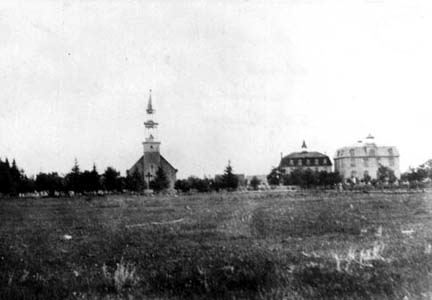Search | Image Archive | Reference | Communities | POV | Lesson Plans | Credits
 The community of St. Laurent lies on the eastern shores of Lake Manitoba. The first recorded histories of the area, dating back to the early eighteenth century, suggest that the residents of the area were probably Assiniboine, although there is evidence that it was used by the Cree and Saulteaux (Ojibwa), who occupied the White Horse Plains to the south and east. They lived a semi-nomadic existence supported primariliy by fishing and trapping.
The community of St. Laurent lies on the eastern shores of Lake Manitoba. The first recorded histories of the area, dating back to the early eighteenth century, suggest that the residents of the area were probably Assiniboine, although there is evidence that it was used by the Cree and Saulteaux (Ojibwa), who occupied the White Horse Plains to the south and east. They lived a semi-nomadic existence supported primariliy by fishing and trapping.
The first permanent settlement at St. Laurent was established in 1824 by a group of Métis who had been forced off their land near Pembina when the Dakota Territory became a part of the United States. In 1826, the population of the small community was swelled by another batch of refugees; Métis farmers, displaced this time by massive flooding of the Red River Valley. For the next five decades, the community remained small and almost exclusively Métis, although there were a number of Aboriginals who lived in the community.
The residents of St. Laurent made their living by varied means. Before the end of the Buffalo Hunt, they made seasonal trips to Alberta in search of bison. The rest of the year was spent trapping and fishing and tending small farms. The land around St. Laurent was not well suited to cropping, and most residents stuck to raising small herds of dairy cattle, planting only small grain and vegetable crops for personal use.
The Catholic church maintained a strong presence in St. Laurent. In 1857, a mission church and school were established, followed by a convent school in 1896. The influence that the church enjoyed in the community is shown by that fact that for nearly twenty years, from 1881 when the Rural Municipality of St. Laurent was created, an Oblate Missionary, was to serve as reeve. Since many residents could not read or write, they relied on the clergy to assist them in their contacts with other communities and the government.
In the last decade of the nineteenth century, the town emerged as a regional commercial centre, largely as a result of the establishment of a cheese factory, which created a market for locally produced milk. Even with the cheese factory, few families were entirely reliant on their farms, and many continued to supplement their farm income by trapping and fishing.
In the early twentieth century, the face of the community changed again when a number of families from Quebec and the Ukraine, as well as some Québécois from the United States, settled in the area. These people were lured by the prospect of cheap land: land in the south had become very expensive and was beyond the reach of many immigrants. With these new arrivals, St. Laurent area became more agricultural, with a greater reliance on field crops.
TimeLinks Characters: Laurence Lagimodière, a Métis farmer lives in St. Laurent with his family.
Page revised: 29 August 2009